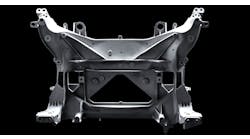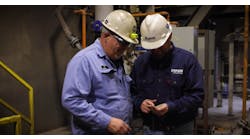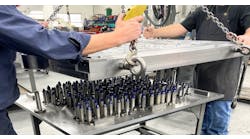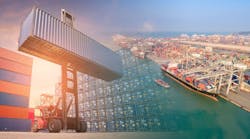Any metalcasting operation has a lot of skilled, in-house contributors, but few foundries are self-sufficient: They depend on a supply chain for everything, from raw materials to shipping services.
These are valuable partners, but they also put you in a vulnerable position. Disruptions in the supply chain can seriously affect your business. So, let’s explore some of the ways you can prepare for and mitigate the potential risks to your chain.
Understand the influence of your chain
It’s difficult to manage supply-chain risks without understanding them, so performing a thorough review should be a first step for any metalcasting manager. Your assessment should focus on a variety of internal and external factors, including:
- Sources of raw materials: Some foundry raw materials will be metals and alloys, while others might be sundries like chemical sand additives or mold release agents. Your assessment should include establishing the primary sources for each of these raw materials, especially if you’re using an intermediary to supply them. Knowing where your materials come from can help you research any likely causes of disruption in the future.
- Socio-political circumstances: Challenging socio-political circumstances in territories where members of your supply chain operate can cause disruptions. For instance, attacks on vessels traveling the Red Sea often disrupt shipping. Assessing your chain for present or oncoming risks here can give you useful data.
- Economic factors: The economic stability of your supply chain is key. Suppliers going bankrupt can unexpectedly remove a link from your chain. Couriers adding surcharges to manage their experience rising fuel prices could affect your profit margins. A good understanding of the economic factors affecting your supply chain helps you make informed decisions.
You need more than awareness of risks. It’s vital to get a good sense of how disruptions could affect your operation. Performing a business impact analysis is essential for making realistic recovery plans. Your assessment should involve key staff from each department, as they’ll have direct insights into the issues that could affect operations. The goal should be to predict the impact on different functions, and the likely severity of each disruption on operations. From there you can prioritize the measures for recovery.
Remember that risks shift. You’ll need to perform these assessments regularly. Adopting solid digital data analytics tools can be useful to gaining regular visibility of supply-chain stability and even predict issues. The better you understand the potential disruptions, the more robust and relevant your protective measures can be.
Recycle and repurpose
Recycling and repurposing help make metalcasting operations more sustainable, an important ethical and business consideration in the face of climate change. It can also make your operation more robust amidst potential supply-chain risks, because treating materials more mindfully minimizes waste and may extend the availability of your inventory.
Some of the materials you might consider for recycling and repurposing in your foundry include:
- Metals: All metalcasting operations salvage scrap for return or recycling. It’s important to understand what the purity and integrity of the metals are, to ensure you make the most appropriate choices for reuse.
- Casting wax: Lost wax foundries can recycle wax; repurposing even small amounts can maximize resources.
- Clay: Clay used in molds can often be reused or recycled. You may need to remove a layer of the clay that has become contaminated or burned, but the remainder can usually be repurposed and has a long shelf life.
Your approach to recycling and repurposing obsolete goods and overstock is important, too. Being organized about your inventory is financially responsible and adds a layer of protection against supply chain issues. Start by identifying what is truly excess stock. Supply chain forecasting can help you to understand whether items of apparent overstock may be in demand in the future, or even if potential issues make it wise to keep extra inventory, to navigate shortages.
Once you’ve established what goods are obsolete or overstocked, you can make plans to recycle or repurpose them. Items that cannot be repurposed or recycled might be donated - and this is often tax-deductible, strengthening your working capital in a way that gives you more breathing room should supply chain issues result in price rises.
Diversify sources
Another way to manage supply chain risks is to diversify your sources. Being overly reliant on single sources of materials or individual vendors can put you at greater risk. Diversification means that should one link in your chain experience disruption, it doesn’t necessarily have a negative impact on the rest of the workflow.
A good first step is to use multiple sources for supplies of each material. Preferably, choose partners from different geographical, economic, or cultural spaces. This will make it less likely that all your sources of materials will experience the same disruption at the same time. If you choose to rely on a primary provider for each material or service, identify alternative sources that you can switch to in an emergency.
Many foundries outsource their mold tooling. 3D printing is a way to bring some mold or core production in-house. While a foundry may not be able to produce all its tooling, it can reduce its reliance on unreliable sources.
Remember that while having a diverse range of supply chain partners can be useful, you still need to build solid relationships with each source. Your suppliers can alert you to potential problems, which empowers you to prepare to pivot more effectively. Partners may even be able to introduce you to alternative vendors for other links in the chain that are more robust or reliable.
Conclusion
The multifaceted nature of metalcasting means that your operation is vulnerable to supply chain risks. The key to managing these effectively is to better understand the risks to your operation and take decisive steps, like recycling materials and diversifying partners. It’s also vital to be cognizant of emerging risks, such as environmental or weather shifts caused by climate change or skills gaps in connected industries. By keeping on top of these potential disruptions, you’re empowering your foundry to thrive.
Ainsley Lawrence is a freelance writer and editor.









